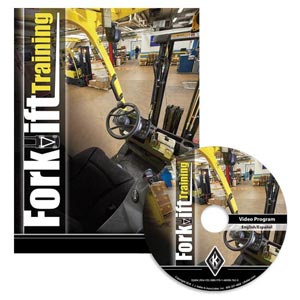Motorized Pallet Jacks: Safe Operation Streaming Video Training Program - English
Streaming Video Training Program provides training regarding the safe operation and dangers of the two most common types of motorized pallet jack trucks: "walkies" and "walkie-riders."
Product Code:41361Ordering Note: When ordering Streaming Video Training Program, you will be provided a link to access the program you purchased. You will have 5 consecutive days to access the program starting from the time you click the link.
- Streaming Video format allows trainers to conduct effective, affordable training wherever they have Internet access
- Includes 5 days of access to the video plus downloadable Trainer's/Instructor's Guide, quizzes and answer keys, a training log and supplemental video content
- Program is viewable from video-capable, internet-connected mobile devices such as an iPhone and iPad, as well as most Android tablets and phones
- Helps meet the requirements of OSHA's Powered Industrial Trucks Standard 1910.178(l)
- Takes a unique but practicable approach by focusing on the motorized pallet jack's use from the start of the work day until the end - including the potential dangers and hazards that operators face along the way
- Length: Approximately 20 minutes
What's Included
- 20-Minute Video - Combines engaging video and editing technology with expertise from industry professionals at all levels
- Introduction
- Importance of Training
- Motorized pallet jacks are just as numerous and pose the same kinds of hazards that forklifts do
- Consequences if they’re misused or not operated properly
- Operators need to be trained on the specific type of powered industrial truck they operate. If an operator is trained and certified to operate a forklift it doesn’t mean they’re automatically qualified to operate a motorized pallet jack
- Operations and Controls
- There are many different models of motorized pallet jacks offered by many different manufacturers
- Most common models used in workplaces are “walkie” or “walkie-rider” models
- Lift height and weight capacity vary by manufacturer and model but most can lift a load as high as 6 inches off the ground and can carry as much as 8,000 lbs
- Steering handle regulates the lift, lower, speed, direction and braking
- Common differences among manufacturers and models include:
- Where the controls are located
- How high the carriage can lift
- Load capacity
- It’s important that each operator be properly trained on the specific model they are about to use
- Accidents
- Most accidents are the result of an operator not following safe operating procedures or being unfamiliar with the controls of a specific model of pallet jack. Reported accidents include:
- Pedestrians getting caught between the pallet jack and a fixed object
- Pedestrians having their feet or toes run over
- Pedestrians hit by a falling load (due to an unsecured load and/or too fast turn)
- Operators engaging in horseplay such as riding on a walkie pallet jack
- Operators are crushed or even killed by a pallet jack that rolls off the edge of a ramp or loading dock
- Most accidents are the result of an operator not following safe operating procedures or being unfamiliar with the controls of a specific model of pallet jack. Reported accidents include:
- Safe Operating Procedures
- Pre-Use Inspection: The importance of inspecting the pallet jack prior to each use to ensure that any defects are reported and fixed before it is used
- Getting a Load: Proper techniques on approaching and securing a load
- Traveling with a Load: The “do’s” and “don’ts” when traveling with a load including safe travel heights, proper sight lines, correct hand positions on the controls, negotiating intersections, safe turning, and more
- Navigating on ramps and inclines
- Maneuvering in tight spaces
- Delivering a Load: Safe operating techniques such as coming to a complete stop before lowering the load and making sure the forks are completely lowered before pulling out
- Parking: Rules and what steps to follow when parking a pallet jack
- End of Shift: Proper procedures for shutting down and storing a pallet jack for the next day’s use
- Conclusion
- Bonus Materials - Total running time: approximately 12 minutes
- Review: Safe Operating Procedures (Running time: 7 minutes)
- Note to Trainers (Running time: 5 minutes)
- Trainer Guide
- Quiz (with Answer Key)
- Alternate Quiz (with Answer Key)
- FAQs
- Powerpoint® Presentation (1)
- Learning Activity - Operations and Controls
- Learning Activity - Data Plates
- Learning Activity - Power Down
- Evaluation Form - Daily Checklist
- Evaluation Form - Operation Evaluation Form
- Images (15)
- Posters (2)
Order supplemental training materials not included with the streaming video option: Operator Handbook. Please allow time for delivery of supplemental training materials prior to your streaming video training session.
What's Covered
After completing this program, learners will understand critical information about:
- The two most common types of motorized pallet jacks and their controls
- "Walkies"
- "Walkie-Riders"
- Load and lift capacities
- Common pallet jacks accidents
- Safe operating procedures
- Pre-use inspection tips
- Picking up a load
- Traveling with a load
- Navigating on ramps and inclines
- Maneuvering in tight spaces
- Delivering a load
- Parking safety
- End of the day procedures
Recordkeeping
Free Recordkeeping Tool
Training documentation is essential – and sometimes required. Our free recordkeeping tool enables you to keep track of any training session on any topic – regardless of the training format you purchase.
You’ll know which employees trained on which topics and when. All you have to do is register now to get started.
Interested in a license to use J. J. Keller content on your intranet or LMS?
For a quote to use this training on your company intranet or learning management system, contact us at customsolutions@jjkeller.com or
Language: English
Format: Streaming Video
Copyright Date: 2014






